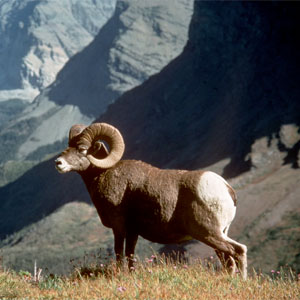Climate change has and will continue to have a negative impact on the population of desert bighorn sheep. For the remaining herds to survive, management may always be necessary. Protecting wild lands is key to the survival of these amazing animals.

NPS photo
The desert bighorn sheep ranges through the dry, desert mountains of eastern California, much of Nevada, northwestern Arizona, and southern Utah. They prefer a habitat of steep, rocky terrain for escape from predators, bedding, and lambing. Desert bighorn sheep zigzag up and down cliff faces with incredible ease. They use ledges only two inches wide for foot holds, and bounce from ledge to ledge over spans as wide as 20 feet. They can move over level ground at 30 miles per hour and scramble up mountain slopes at 15 miles per hour. They are aided by cloven hooves which are sharp-edged, elastic, and concave.
In 2010, the National Park Service (NPS) began to study the link between population declines of desert bighorn sheep and the effects of climate change. Climatic variables such as rising temperatures and decreased precipitation affect the availability of vegetation and dependable sources of spring water for the desert bighorn sheep. Water is critical to desert bighorn sheep survival. Lactating ewes need to drink almost every day. Animals like desert bighorn sheep also need large areas of land in which to mix herds. Desert bighorn sheep primarily live in small, isolated herds throughout the mountain ranges of the Sonoran, Mojave, and Great Basin deserts of the southwestern United States. There are ten national parks home to the majority of these groups, and the NPS plays a critical role in the conservation of this species.
The NPS seeks to maintain and mix existing populations of desert bighorn sheep. This direct, on-the-ground management action is the best means for offsetting the unpredictable but potentially devastating changes in precipitation and temperature predicted for the American southwest. The NPS partnered with universities and other government agencies in a collaborative effort to address these concerns. They used non-invasive, state-of-the-art, standardized testing to evaluate the impacts of climate change and identify herds and habitats that are most vulnerable to these changes. As a result, the NPS identified specific options to maintain desert bighorn sheep populations in and around national park units and focused limited resources on the populations that are most threatened by climate change. High priority sites identified by the NPS will have the greatest ability to create more robust populations of desert bighorn sheep that can better respond to the adverse effects of a dryer, warmer climate in the southwest. Additionally, materials and on-site training have been implemented in park educational programming.
Last updated: February 3, 2015
